
* The Soviet experimental design bureau (OKB in its Russian acronym) headed by Andrei Tupolev is best known for its series of bombers, but it also developed a series of jet airliners, including the "Tu-104", "Tu-124", "Tu-134", "Tu-154", and "Tu-204". This document provides a history and description of these aircraft.
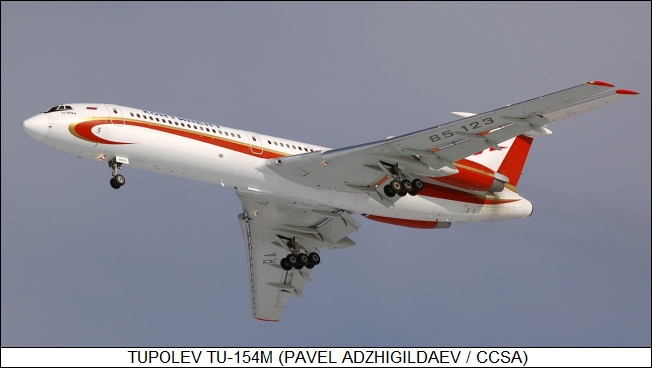
* In the early 1950s, the Tupolev OKB developed the Tu-16 "Badger" bomber, a swept-wing design powered by twin Mikulin RD-3 turbojet engines. In parallel with the design effort on the bomber, the organization also worked on a jetliner derivative.
Formal work on the jetliner began in the spring of 1953, with the initial flight of the prototype of the "Tu-104", as the machine was designated, on 17 June 1955, with Y.I. Alashayev at the controls. The Tu-104 went into service with the Soviet state airline Aeroflot in 1956, with the new, advanced jetliner causing a stir in the West when it arrived in foreign capitals with Soviet bigwigs on board. The type was assigned the unflattering NATO reporting name of "Camel".
The Tu-104 used wings and tail derived from the Tu-16, fitted to an airliner fuselage; there were some minor detail differences in the Tu-104's flight surfaces relative to the Tu-16. Like the Tu-16, the Tu-104 featured low-mounted swept wings and twin RD-3 engines, with 93.2 kN (9,500 kgp / 20,950 lbf) thrust each, in nacelles next to the fuselage, and four-wheel main landing gear assemblies, using 2x2 bogies, in pods on the wings -- the landing gear wing pod scheme being something of a Tupolev trademark.
The Tu-104's pressurized fuselage was 3.4 meters (11 feet 2 inches) in diameter, compared to 2.9 meters (9 feet 6 inches) for the Tu-16. The Tu-104 was flown by a crew of five including pilot, copilot, radio operator, flight engineer, and navigator. The aircraft featured navigation radar in a fairing under the nose and nose glazing for the navigator, a distinctive feature found on many Soviet airliners.
Initial accommodations were for 50 passengers. Passenger headspace was limited where the wing spars went across the fuselage, and so there was a galley separating front and back seating sections at that point. In the initial production version, there were two "first class" sections forward of the wing, with six passengers in the forward section and eight in the second, both featuring tables and other niceties. There was another eight-passenger section behind the galley, followed by "coach" seating for 28, in seven rows four seats across.
There was a toilet forward and two toilets aft. Apparently the accommodations were spiffy, particularly by Soviet standards, with brass and mahogany fittings; obviously, the Tu-104 was seen as "showpiece" for Soviet technology and industry. It did have a longer take-off run than the Soviet propliners then in service, requiring the extension of runways at a large number of airports in the USSR to handle the new machine, but that would have had to be done in any case as aircraft performance improved.
Uprating the RD-3 engine increased the gross take-off weight, leading to the "Tu-104A", which was introduced to service in 1957 and could carry 70 passengers, with five-abreast seating. A Tu-104A set a series of altitude and speed with load records in 1957.
Development of the "RD-3M" engine, with 85.3 kN (8,700 kgp / 19,180 lbf) thrust, led to the definitive "Tu-104B" variant, which was introduced in 1959. It featured a 1.21 meter (4 foot) fuselage stretch, wings with wider chord and bigger flaps to handle the weight increase, various general improvements, and accommodations for 100 passengers. The early compartmentalized scheme gave way to straight-through accommodations of 30 passengers before the wing, 15 passengers in the center section, and 55 behind. The Tu-104B also set a series of altitude and speed with load records in 1959.
___________________________________________________________________
TUPOLEV TU-104 CAMEL:
___________________________________________________________________
wingspan:
34.54 meters (113 feet 4 inches)
wing area:
183.50 sq_meters (1,975 sq_feet)
length:
40.06 meters (131 feet 5 inches)
height:
11.90 meters (39 feet)
empty weight:
41,600 kilograms (91,710 pounds)
MTO weight:
76,000 kilograms (167,550 pounds)
max speed at altitude:
950 KPH (590 MPH / 515 KT)
service ceiling:
11,500 meters (37,750 feet)
range:
3,100 kilometers (1,925 MI / 1,675 NMI)
___________________________________________________________________
A number of Tu-104As were converted to a 100-passenger configuration and redesignated "Tu-104V". That sounds a little cramped, and not surprisingly there was a "Tu-104D" conversion that had more reasonable accommodations for 85 passengers. There was also a single "Tu-104E", which was a Tu-104B tuned for record-breaking flights. A number of Tu-104s of various types were used for special applications, including weather research, and as a "vomit comet" to perform dives that would allow Soviet cosmonauts to experience short periods of zero gee before going into space. Two Tu-104s were fitted with YeN radar to serve as trainers for the Tu-16K-10 "Badger-C" bomber and were designated "Tu-104Sh". They were later upgraded with radar and systems for the Tu-22M "Backfire" bomber, and redesignated "Tu-104Sh-2".
The last of about 200 Tu-104s was rolled out in 1960. The only export user was CSA of Czechoslovakia, which bought six Tu-104As. Most Tu-104s in Aeroflot service were updated in the late 1960s to handle 104 or 115 passengers, which suggests that the nice trim seen in early production had been dispensed with. The type was finally retired from Aeroflot service in 1981. While crude by modern standards, the Tu-104 was leading-edge at the time of its introduction, and in fact it was the second jetliner to go into full service, following Britain's much less successful de Havilland Comet. Although noisy and fuel-hungry in hindsight, the Tu-104 also had an excellent serviceability and safety record.
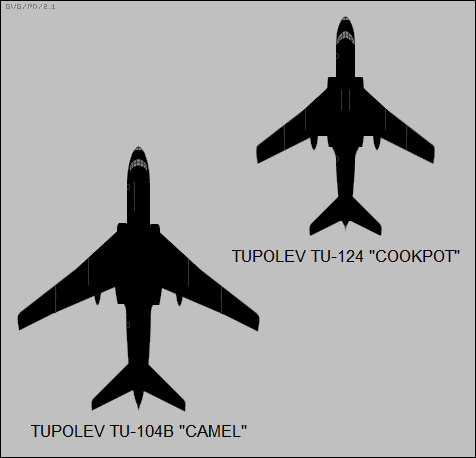
* The Tu-104 had seemed like such a good idea that it was followed in production by a scaled-down derivative, the "Tu-124", which had a very similar general arrangement -- so similar that the two types could be difficult to tell apart -- but length and span only about 75% of the Tu-104, and weight only about half. There was no substantial parts commonality between the two designs. Initial flight of the prototype was in June 1960, with introduction to service in 1962.
The Tu-124 was powered by twin Soloviev D-20P turbofans with 52.9 kN (5,400 kgp / 11,900 lbf) thrust each. The Tu-124 had slightly improved aerodynamics over the Tu-104, giving a sleeker look. The fuselage width was 2.9 meters (9 feet 6 inches), like that of the Tu-16. The Tu-124 was fitted with 44 seats, which was increased to 55 on the "Tu-124V". There were also VIP transport variants, including the "Tu-124K", with 36 seats, and the "Tu-124K2", with 22 seats. About a hundred Tu-124s of all types were built, to be operated on short-haul routes through the 1960s and 1970s. It was assigned the quirky NATO reporting name of "Cookpot".
___________________________________________________________________
TUPOLEV TU-124 COOKPOT:
___________________________________________________________________
wingspan:
25.55 meters (83 feet 10 inches)
wing area:
119 sq_meters (1,281 sq_feet)
length:
30.58 meters (100 feet 4 inches)
height:
8.08 meters (26 feet 6 inches)
empty weight:
22,500 kilograms (49,600 pounds)
MTO weight:
38,000 kilograms (83,755 pounds)
max speed at altitude:
970 KPH (605 MPH / 525 KT)
service ceiling:
15,000 meters (49,200 feet)
range:
2,100 kilometers (1,305 MI / 1,135 NMI)
___________________________________________________________________
A few Tu-124s served in the Red military as "Tu-124Sh" navigation trainers. Three were supplied to the Czech CSA airline, and two to the East German Interflug airline. A handful were also sold to the Iraqi and Indian air forces as VIP transports. Like its bigger sister, the Tu-124 obtained a reputation for serviceability and safety.
* There were several other branches from the Tu-104 line besides the Tu-124, none of which went anywhere. There was consideration of a "Tu-107" military cargolifter based on the Tu-104, with a production Tu-104 converted to a prototype, which performed trials from 1958. The Tu-107 was generally similar to the Tu-104 except for a reduced number of windows, a tail turret with twin AM-23 23-millimeter cannons, and a tail loading ramp. It could carry up to 100 troops, 70 paratroops, or one or two combat vehicles. It was basically limited by the fact that the tail loading ramp couldn't be opened in flight and paradropping heavy loads was impossible; the Tu-107 did not go into production.
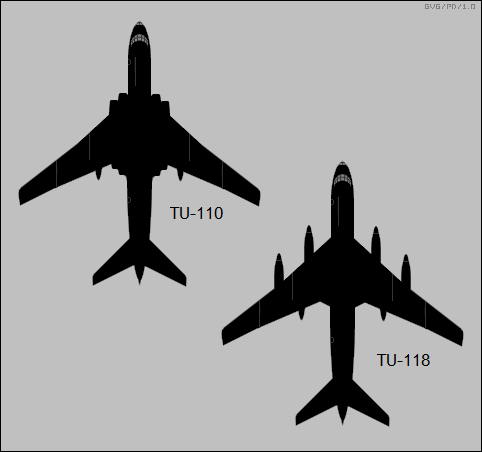
A "Tu-110" was also developed roughly in parallel with the Tu-104, being much the same except for fit of four smaller AL-5 turbojets, with 53.9 kN (5,500 kgp / 12,125 lbf) thrust each, instead of the two big RD-3s. Although the Tu-110 apparently had some advantages over the Tu-104, the four engines in particular providing greater flight safety, they weren't significant enough to encourage production; the sole Tu-110 prototype was turned over to the Red Air Force, apparently for use as a VIP transport. A "Tu-118" with four TV-2F or NK-8 turboprops, in the 4,475 to 5,970 ekW (6,000 to 8,000 EHP) range and driving contra-rotating propellers, was considered to extend range, but not built.
BACK_TO_TOP* Tupolev OKB engineers felt they could improve on the Tu-124, and after considering various options a team under Leonid Selyakov came up with a successor to the Tu-124, moving the twin engines mounted in the wingroots to the tail, and fitting a tee tail. The new machine was originally designated the "Tu-124A" -- apparently it leveraged off Tu-124 assemblies -- with six development aircraft built, the first flying in December 1963. Production began in 1964 at a factory in Kharkov, though it wasn't until September 1967 that Aeroflot, the Soviet state airline, put the aircraft into full commercial service as the "Tu-134". NATO assigned the type the eccentric reporting name of "Crusty".
The Tu-134 had a general configuration similar to that of the US Douglas DC-9. The production aircraft was powered by twin rear-mounted Soloviev D30 low-bypass turbofans with 66.7 kN (6,800 kgp / 14,990 lbf) thrust each; the initial Tu-124A prototypes had featured Soloviev D20P turbofans, with about 20% less thrust. There were three fuel tanks in each wing, providing a total fuel load of 16,500 liters (4,353 US gallons).
The two-spar wings featured a sweepback of 35% at wing midline, an anhedral droop of 1.3 degrees, four-section flaps and two-section ailerons, with spoilers / lift dumpers on top of the wing. The tailplane had conventional elevators, but featured adjustable incidence for pitch trim. There was an airbrake under the fuselage, used for reducing speed on approach. All flight controls were manual except for the tailplane incidence adjustment, which was electrically actuated.
The nose landing gear featured twin wheels while the main gear assemblies featured four wheels. All landing gear assemblies retracted backwards, each main gear assembly being stowed in the traditional Tupolev fashion in a pod at the rear of the wing. Disk anti-skid brakes were fitted. The tailplane featured an electrical de-icing system, while the wings, tailfin, and engine inlets were de-iced by engine bleed air. The windscreen used both hot air and electrical de-icing.
Flightcrew included pilot, copilot, and navigator, plus two stewardesses, with nose glazing to allow the navigator to make observations, and weather radar mounted in a radome under the nose. Other avionics were basic but state-of-the-art -- radios, landing aids, navigation aids, and identification transponder.
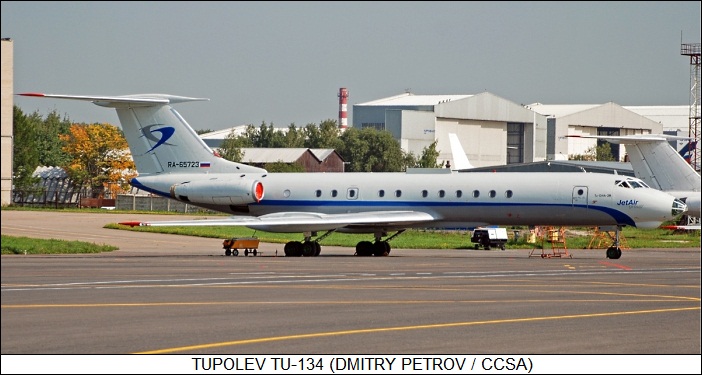
The load capacity was 72 passengers in a single-class configuration, sitting four abreast; 64 passengers could be accommodated in a two-class configuration, with 16 first class passengers in the forward compartment, 20 economy in the middle compartment, and 28 economy in the rear compartment. There were two galleys and two toilets. There were no underfloor cargo holds, with luggage stowed behind the pilot's compartment and at the rear. There was only a single passenger door, on the left forward fuselage, with cargo doors for each cargo compartment on the right, and an emergency exit over each wing.
___________________________________________________________________
TUPOLEV TU-134:
___________________________________________________________________
wingspan:
29 meters (95 feet 2 inches)
wing area:
127.3 sq_meters (1,370 sq_feet )
length:
34.35 meters (112 feet 8 inches)
height:
9.02 meters (29 feet 7 inches)
empty weight:
27,500 kilograms (60,630 pounds)
MTO weight:
44,500 kilograms (98,105 pounds)
max cruise speed:
900 KPH (560 MPH / 485 KT)
efficient cruise speed:
750 KPH (465 MPH / 405 KT)
service ceiling:
12,110 meters (39,730 feet)
range, 7 tonne load:
2,400 kilometers (1,490 MI / 1,295 NMI)
range, 3 tonne load:
3,500 kilometers (2,175 MI / 1,890 NMI)
___________________________________________________________________
The Tu-134 featured various upgrades in service, most significantly fit of an auxiliary power unit (APU) turbine engine for main engine starting (the APU output driving electrical starters) and ground power. Clamshell thrust reversers were then added, with the modified engines designated D30 Series II. Avionics were continuously updated.
* The initial production Tu-134 was followed in 1970 by the "Tu-134A", which had a fuselage stretch of 2.1 meters (6 feet 11 inches) to 37.05 meters (121 feet 7 inches); the APU introduced on upgraded Tu-134s; and more powerful D32 / D30 Series III turbofans providing 69.4 kN (7,080 kgp / 15,610 lbf) thrust each, along with improved "hot and high" performance. A prominent recognition feature was a needle-like VHF radio antenna mounted in the front of the tee-tail bullet fairing.
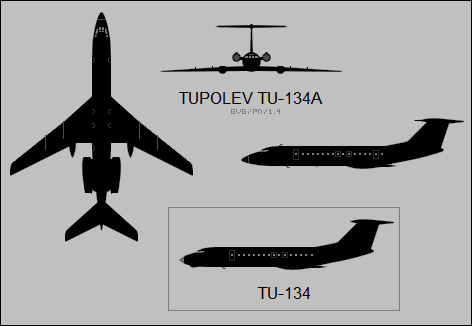
Load was increased to 84 passengers in a single-class configuration, or 12 first class and 54 economy class passengers, with expanded baggage accommodation. Empty weight was raised by 1,550 kilograms (3,420 pounds) to 27,500 kilograms (60,640 pounds). The landing gear and wings were reinforced to handle the higher weight. Later production eliminated the nose glazing, which was seen as "draggy", replacing it with an improved radar system. Some older production was also refitted with the new nose.
* Final production included the "Tu-134A-3", with new lightweight seats to permit a single-class load of 96 passengers; and then the "Tu-134B", with modernized cockpit accommodations that eliminated the navigator position. Sources also mention a few other minor variants, notably military crew trainers -- including the "Tu-134BSh", which was fitted with the nose of a Tu-22M "Backfire" bomber.
Production ended in 1978. Sources give the number built as about 800. Most Tu-134s served with Aeroflot, though it was popular with the airlines of Eastern European nations and some Soviet client states as well. It was regarded as fairly stereotypical Soviet hardware: heavy, with poorer fuel economy and passenger load than, say, a DC-9, but very sturdy and easy to keep flying. Only a handful were still in service at last notice.
BACK_TO_TOP* The Tu-104, the first production Soviet jetliner, led to the downscaled Tu-124, which led in turn to the Tu-134. The Tu-104 itself led to a more modern replacement, the "Tu-154".
The Tu-154's design specs included the ability to operate off of rough or short airstrips and good altitude performance, to allow it to fly above most Soviet air traffic. A Tupolev engineering team, originally under S.M. Yeger and later under Dmitriy Markov, developed an aircraft with a general resemblance to the Boeing 727, featuring low-mounted swept wings, a swept tee tail, and three engines -- Kuznetsov NK-8-2 low-bypass turbofans providing 93.2 kN (9,500 kgp / 20,950 lbf) thrust each, with one mounted in the base of the tail and one mounted on each side of the rear fuselage. An APU was provided for engine starting and ground power.
The Tu-154 differed significantly from the Boeing design in retaining the distinctive Tupolev approach of mounting the main gear in wing pods. Each wing featured three spars, five-section leading-edge slats, two-section triple slotted flaps, one-piece ailerons, and an array of spoilers / lift dumpers / airbrakes on top. Wing, tail, and engine inlet de-icing was performed using engine bleed air, while the slats were electrically de-iced. The steerable nose gear featured dual wheels. Each main gear assembly featured six wheels, mounted on a bogie in three rows of two wheels. All landing gear assemblies retracted hydraulically to the rear. Flight crew consisted of pilot, copilot, navigator, flight engineer, and at least two stewardesses. Typical single-class seating was 128, six abreast, or 146 in a high density configuration.
Initial flight of the Tu-154 was on 4 October 1968, with initial delivery of a production machine to Aeroflot in early 1971 and introduction to service a year later. It was given the NATO reporting name of "Careless".
___________________________________________________________________
TUPOLEV TU-154:
___________________________________________________________________
wingspan:
37.55 meters (123 feet 3 inches)
wing area:
201.5 sq_meters (2,168 sq_feet)
length:
47.9 meters (157 feet 2 inches)
height:
11.4 meters (37 feet 5 inches)
empty weight:
43,500 kilograms (95,900 pounds)
MTO weight:
90,000 kilograms (198,415 pounds)
max cruise speed:
975 KPH (605 MPH / 525 KT)
efficient cruise speed:
900 KPH (560 MPH / 485 KT)
service ceiling:
12,110 meters (39,730 feet)
range, max payload:
3,460 kilometers (2,150 MI / 1,870 NMI)
range, max fuel:
5,280 kilometers (3,280 MI / 2,850 NMI)
___________________________________________________________________
The initial series Tu-154 was followed in 1974 by the "Tu-154A". It was difficult to distinguish from the Tu-154, but featured uprated NK-8-2U engines providing 103 kN (10.5 kgp / 23,150 lbf) thrust each, permitting an increase in take-off weight and, with the addition of new emergency escape doors, a maximum passenger load of 168. There were various improvements in systems. A new fuel tank was added in the center section, but oddly it couldn't be used in flight; the fuel was transferred on the ground to other aircraft fuel tanks.
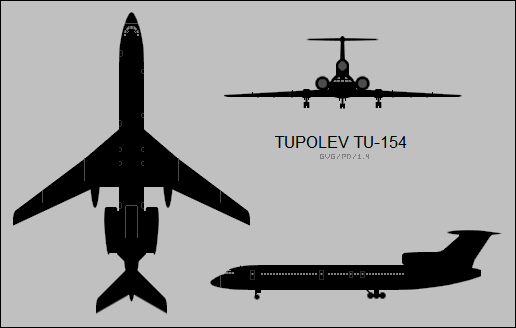
The Tu-154A was followed in turn in 1977 by the "Tu-154B" variant, which quickly evolved to the "Tu-154B-2". The major change was still more max take-off weight, allowing (with more emergency exits) a passenger load of 180. The center section fuel tank was integrated into the rest of the aircraft fuel system, and a number of small changes were implemented. In the early 1980s a "Tu-154C" air freighter was introduced, such machines amounting to conversions of Tu-154A/B aircraft with a cargo door on the forward left fuselage and cargo handling facilities in the cargo hold. Max cargo load was 20 tonnes (22 tons).
* The first series Tu-154s led in 1981 to the second-series "Tu-154M", which featured much more economical, quieter, and reliable Soloviev (later AviaDvigatel) D-30KU-154-II turbofans -- through the max thrust provided by the new engines was about the same as that of the NK-8-2U, 104 kN (10,600 kgp / 23,380 lbf) each. The engine intakes had to be expanded to handle the greater airflow. The Tu-154M featured about 20% better range and an increase in max take-off weight of about 10,000 kilograms (22,000 pounds) relative to the baseline Tu-154. Maximum passenger capacity was 180 in a six-abreast configuration.
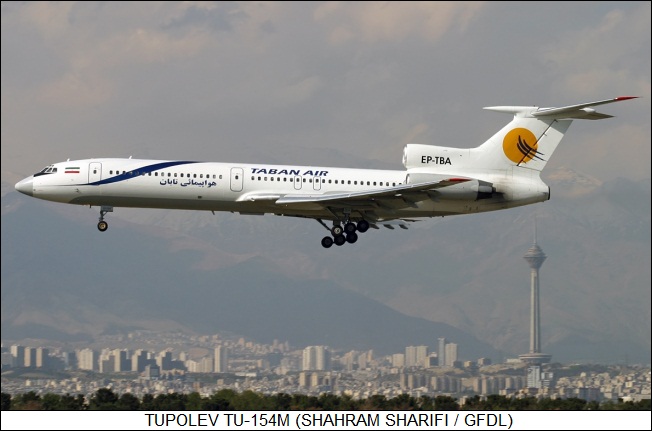
About 850 Tu-154s were built in all, with over 70% of them being Tu-154Ms. Again, most were obtained by Aeroflot, but many were also provided to the airlines of Eastern European and Soviet client states. China obtained a number of them, with at least four modified to a special missions / surveillance configuration with large belly fairings fore and aft of the wings -- these machines being operated by the Chinese People's Liberation Army Air Force. The Tu-154 was regarded as clearly less economical to operate than a Boeing 737, but much sturdier and easier to maintain. The Tu-154 remains in service, but it is approaching the end of its days.
BACK_TO_TOP* By the last days of the Soviet Union in the late 1980s, the Tupolev OKB was working on new jetliners, but the collapse of the USSR threw these programs into some confusion.
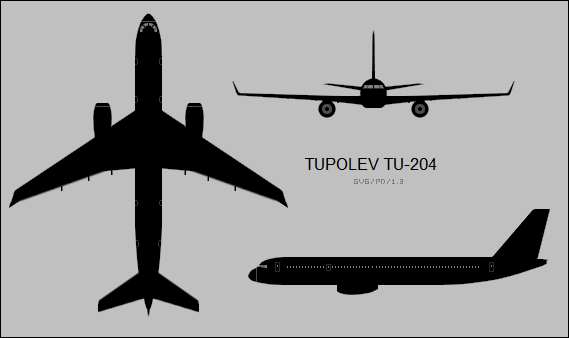
Development of a successor to the Tu-154, as well as the Ilyushin Il-62 jetliner, began in the 1980s, with the first flight of the "Tu-204" on 2 January 1989. It was a modern narrow-body twinjet airliner with a close resemblance to the Boeing 757. It featured a "supercritical" wing with a sweep of 28 degrees and winglets; Soloviev (now Aviadvigatel) PS90 high-bypass turbofans, with 158.3 kN (16,135 kgp / 35,580 lbf) thrust each; a triple-redundant "fly-by-wire" digital flight control system with analog backup; and a "glass cockpit" with six displays.
The airframe consisted of almost a fifth by weight of composite materials, and included both titanium and lithium-aluminum alloy elements. The steerable nose gear had twin wheels, while the main gear assemblies had four wheels. The landing gear featured antiskid disk brakes and was hydraulically actuated, the nose gear retracting forward, the main gear retracting inward into the fuselage -- the Tu-204 did not use the trademark Tupolev wing-pod scheme.
Crew included pilot, copilot, and an optional flight engineer, as well as at least two flight attendants. Seating was six-abreast, with 210 passengers in a high-density configuration and various mixed configurations, such as 24 first class and 159 economy class seats. There were three galleys and three toilets.
___________________________________________________________________
TUPOLEV TU-204:
___________________________________________________________________
wingspan:
41.80 meters (137 feet 2 inches)
wing area:
182.4 sq_meters (1,963 sq_feet)
length:
46.1 meters (151 feet 3 inches)
height:
13.9 meters (45 feet 5 inches)
empty weight:
58,300 kilograms (128,530 pounds)
MTO weight:
94,600 kilograms (208,550 pounds)
cruise speed:
850 KPH (530 MPH / 460 KT)
range, max payload:
2,430 kilometers (1,510 MI / 1,310 NMI)
___________________________________________________________________
A number of variants were introduced or proposed:
The "Tu-214" is an increased-range version of Tu-204-100. Four were obtained by the Russian government as high-level VIP transports. Several special-mission variants of the Tu-214 have been produced.
Other variants under consideration included an "airborne early warning and control (AEW&C)" platform; an electronic warfare variant; and a maritime patrol variant. The Tupolev organization flies a "Tu-214LL" -- the "LL" standing for "flying lab" in Russian -- to evaluate airborne systems.
To appeal to customers who were interested in Western jetliners, the Tupolev organization built a "Tu-204-120" with Westernized (Honeywell) avionics and Rolls-Royce RB211-535 powerplants. The first flew on 14 August 1992. A "combi" freighter variant, the "Tu-120-100C", was built as well, to be followed by the "Tu-120-CE" with higher MTOW. A number of Rolls-Royce powered Tu-204s were sold to Egypt and users in Europe.
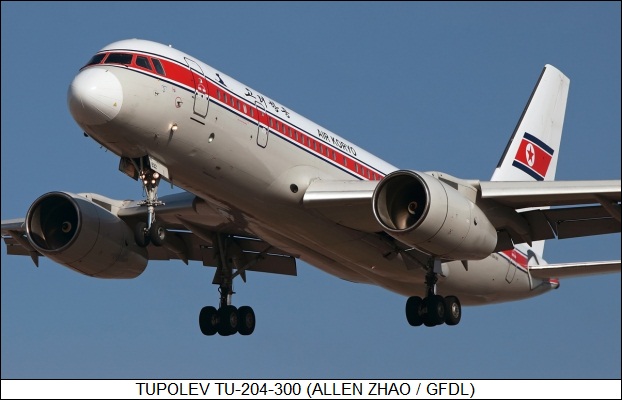
A "Tu-204SM", a modernized derivative of the Tu-204, first flew in late 2010. It featured generally modernized avionics, including a new cockpit and flight computer; much-improved and much more reliable PS-90A2 engines; a new APU; and a new interior, featuring LED lighting.
Total production quantities of the Tu-204 series are unclear, but appear to be modest, about four prototypes and 38 production machines by 2006. Sources give the impression of listing more Tu-204 variants than the actual number of Tu-204s built. Following the disastrous Russian invasion of Ukraine in 2022, which resulted in the withdrawal of technical support for Western airliners in Russian service, the Russian government announced that 20 new Tu-204 series machines would be built. The industrial demands of the war suggest few, if any, of them will be built.
* While the Tu-204 series was a replacement for the Tu-154, the Tupolev organization also developed a "shortened" derivative of the Tu-204, the "Tu-334", as a replacement for the Tu-134. The end result didn't have much resemblance to the Tu-204, in fact resembling a Fokker 70/100 jetliner, with twin rear-mounted turbofan engines, a tee tail, and winglets.
Although the development program was initiated in 1986, it was derailed by the collapse of the USSR, with the first prototype finally performing its initial flight on 8 February 1999; a second prototype was planned at the outset, but it never actually flew. Two more prototypes and an initial batch of "Tu-334-100" production machines were supposedly to follow, with the Tu-334-100 powered by twin ZMKB Progress D436T1 high-bypass turbofans with 73.6kN (7,500 kgp / 16,535 lbf) thrust each.
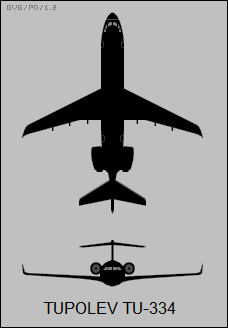
The Tu-334-100 featured fly-by-wire controls, a crew of two or three, and a maximum capacity of 102 passengers in a single-class configuration, six abreast -- or 72 in a two-class configuration, including 12 first-class passengers seated four abreast and 60 economy passengers seated six abreast.
___________________________________________________________________
TUPOLEV TU-334:
___________________________________________________________________
wingspan:
29.77 meters (97 feet 8 inches)
wing area:
83.2 sq_meters (896 sq_feet)
length:
31.26 meters (102 feet 7 inches)
height:
9.38 meters (30 feet 9 inches)
empty weight:
30,050 kilograms (66,250 pounds)
MTO weight:
46,100 kilograms (101,630 pounds)
efficient cruise speed:
820 KPH (505 MPH / 440 KT)
range, full payload:
2,000 kilometers (1,240 MI / 1,080 NMI)
___________________________________________________________________
A range of configurations was considered, including stretched variants, "combi" machines, and Westernized aircraft with Rolls-Royce engines -- but as it turned out, only the two prototypes were ever built. In 2009, in the course of consolidation of the Russian aircraft industry, the decision was made to stop work on the Tu-334, to focus instead on alternative jetliners then in development.
BACK_TO_TOP* Sources:
Several editions of JANE'S ALL THE WORLD'S AIRCRAFT were also consulted.
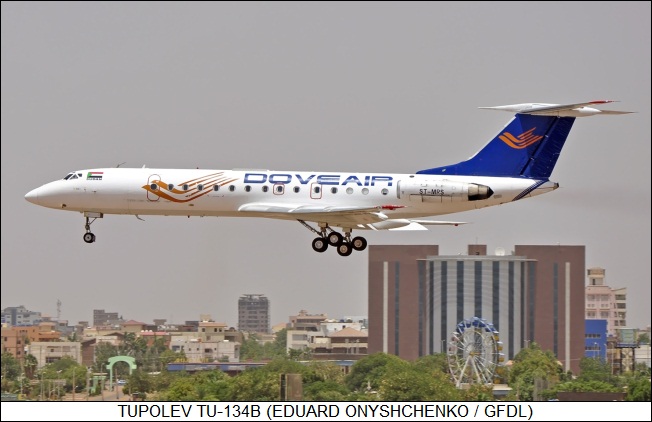
* Revision history:
v1.0.0 / 01 may 08 v2.0.0 / 01 jan 09 / Added Tu-104 & Tu-124. v2.0.1 / 01 dec 10 / Review and polish. v2.1.0 / 01 nov 12 / Tu-214ON and Tu-214R added, Tu-107 and Tu-118 added. v2.2.0 / 01 oct 14 / PLAAF special-mission Tu-154M, Tu-334 cancellation. v2.2.1 / 01 sep 16 / Review & polish. v2.2.2 / 01 sep 16 / Review & polish. v2.2.3 / 01 aug 18 / Review & polish. v2.2.4 / 01 jun 20 / Review & polish. v2.2.5 / 01 apr 22 / Review & polish. v2.2.6 / 01 mar 24 / Review & polish.BACK_TO_TOP
